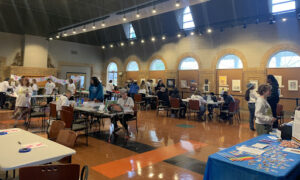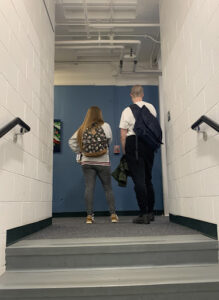By Marissa Hamm
Although we did not have a class meeting this week, Curatorial Practices students were very busy thinking about the Museum of Broken Relationships Indianapolis exhibit and the idea of “fit,” both physically and theoretically.
One of the major ways we are considering fit is in regards to our satellite display exhibits. For these auxiliary exhibits, eight groups are working on small displays of objects from the MBR collection that will be exhibited around the IUPUI campus, and throughout the Indianapolis community. My group is working on a display at the Garfield Park Arts Center (GPAC) on the southside of town. My group members and I are all excited about our location because Garfield Park is an area we regularly frequent, so we are familiar with GPAC’s audience and programming. However, deciding on how MBR can fit within this space still poses challenges.

Recent community art event at the Garfield Park Arts Center. Image Credit: Marissa Hamm, November 5, 2022.
In our initial conversations about how to create a display at GPAC, we came to a few conclusions. First, we believe it would be fitting to have an object on display that is art related in order to appeal to the primary audience at GPAC (artists, art appreciators, families and community members seeking out arts programming). The second decision we came to is to have a one object exhibit. In week seven of Curatorial Practices, we learned about the concept of the single-object exhibit, and how it can be difficult to create, yet impactful for the viewer. The purpose of the satellite displays is to connect with viewers beyond Herron Galleries and also encourage them to explore the rest of the show. Therefore, the small display must be intriguing and moving, but not so heavy so as to deter viewers from wanting to see more of this content. We believe that striking this balance could be best achieved with one object. Now the question is which object.
Part of this decision will be based on physical limitations. Upon visiting GPAC as a group, we tried to identify the most heavily trafficked areas in the building. Although the front lobby is the first point of entry, it is an awkward space without a clear area where a small exhibit could safely be displayed. The next best option, in our minds, would be the second floor landing at the top of the stairs. If we are able to use a work of art on canvas, then it can be displayed on the wall, and it would be the first thing any visitor sees as they make the journey up to the third floor of the building. Although this is our preferred location, the final decision will still come down to fit in terms of what object we display, and what the director of GPAC offers as safe areas to house our satellite exhibit.

Satellite Display group members observe the ideal location for the exhibit at GPAC – the top of the stairs on the second floor. Image Credit: Marissa Hamm, November 5, 2022.
Beyond physical fit, our single-object exhibit requires an object with the right thematic fit, which ties into the other project our class is working on this week: dividing the objects in the Indianapolis collection into themes for the main gallery. After meeting with the MBR team in Zagreb last week, Dr. Holzman put together a spreadsheet that lists the major themes that we discussed in columns, and the list of objects in our collection in rows. Individually, our class must all contribute to this spreadsheet by either picking a few objects and adding marks to which themes they fit within, creating a new theme and adding it to the columns, or focusing on one theme and marking all of the objects that fit within it. Although this seems like a straightforward process, it is actually quite complicated because not every object easily fits into a thematic box, and not every student has the same interpretation of what each theme and object means.
One example of the difficulty of working with many people that I experienced is with an object in our collection that is related to a person’s childhood relationship with their grandmother. Of the themes we currently have, one is simply called “relationships from youth.” Therefore, in my mind, this object fits into this theme because it was a relationship that the person had with their grandmother as a child, which is now broken through disagreement and death. However, in my classmates’ minds, this theme may only be referring to romantic relationships among young people. There are multiple ways to interpret each theme and object, and I imagine this will be a point of discussion as we move forward with our exhibit. In week three of class, we discussed the concept of co-curating, and now we are all experiencing it firsthand. We are trying to create an exhibit using the voices of the Indianapolis community members who donated, the viewpoints of the 28 students in our class, the expertise of the MBR team in Croatia, and the perspective of our professor. There are many voices that must come together in one, cohesive exhibit.
As the thematic side of our exhibit planning comes together, what object fits best for our satellite display will become clearer. So although we have ideas now of what might be at GPAC, we are keeping an open mind to make sure that we find the perfect physical and thematic fit to grab visitors’ attention and motivate them to seek out more of the Museum of Broken Relationships.
Marissa Hamm is a second-year Museum Studies graduate student at IUPUI.

